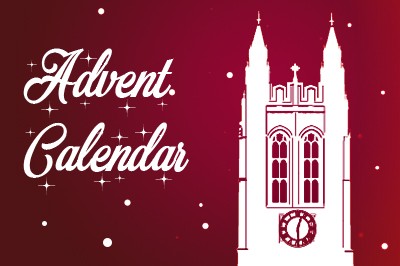Christina Dimitri ’22
Image By: Christina Dimitri ’22
Almost everyone, even many non-believers, agrees that Christmas is a magical day. We dress it up as one, with lights on our windows and decorations on our doorways. The tinsel and the music and all of the stories of the supernatural around this time can conjure up images of a fantasy land.
To some extent, the emphasis on the magical is helpful: it reminds us that today is a day when the unimaginable happened, when God the Almighty came to be with us as an infant, utterly dependent. The famous prologue from John’s Gospel, proclaimed on Christmas Day, identifies this as the moment when “The Word became flesh and made his dwelling among us” (John 1.14). To paraphrase the poet W. H. Auden, now is when the infinite becomes a “finite fact.” So we remind ourselves of that possibility when we introduce a little magic to our homes, when we magnify the wonder and awe of our surroundings.
But there is a risk in making this season too magical: We might turn Christmas into a fairy tale, an inspiring legend of “once upon a time” that reminds of some nostalgic yesterday. The whole point of the feast, of the readings today, is that this isn’t a fairy tale but rather that 2,020 years ago (more or less), the Word of God, the spiritual fabric of the cosmos, “the refulgence of God’s glory,” spoke to us as Jesus (Hebrews 1.3). In the words of the first reading, this is the moment when the Lord has bared his holy arm (Isaiah 52.10). These are very real, historical, physical facts, and if we don’t say yes to their reality, then we miss the point of Christmas. God didn’t become an idea or a story we tell: he became a human being, Jesus Christ.
And these are facts that push against what so many understand as “faith” in our time. Many people like the magic of Christmas because, well, it doesn’t ask much of them: buy a few presents, celebrate with family, share some cheer. This is a spiritual celebration only in the vaguest sense: Christmastime lifts our hearts, without weighing us down with the grim side of religion, all the rules and regulations.
But the fact that God, the creator of the universe, came to be with us in physical, bodily form means that our faith isn’t just a spiritual, bodiless commitment. In fact, God came in human form because he knew that we’re bodily creatures: we’re drawn to things we can touch and feel and taste. And he knows that spirituality isn’t just a mental affair. In fact, the Incarnation is such a wild idea that we do something with our bodies to recall it: if you can be present at the Mass this Christmas (and if the congregation remembers!), we all kneel at the proper moment in the creed (“he became incarnate of the Virgin Mary”).
There’s an ancient term for how God comes to us on our humble, bodily level: “condescension” (sunkatábasis). The term need not carry the connotations of the modern usage, as in, “My teacher was so condescending when he corrected me.” Rather, the term suggested how someone might “come down to our level.” In my family we have some new babies, and all of the adults are practicing this sort of condescension: using voices the children might understand, waving to catch their attention. To speak to us in our language, God came and walked among us. He knew that ideas and stories and, well, magic, weren’t enough to save us: he needed to be with us on our terms.
And because God has a body, following God involves our offering bodies: getting our rear-ends to Church (or at least to a virtual Mass!) on Sunday, biting our lips when we’re ready to say something stupid or vicious, turning our eyes when we’re tempted by an inappropriate image, offering an embrace to someone in need. And it’s only by doing the bodily things required by discipleship that we can speak the language of faith to our friends and relatives, whom we want to join us in discipleship.
There’s a particular way that the readings for the Nativity reinforce the embodiment of our celebration. In Luke’s account, read on Christmas morning, we learn that the Christ-child was laid in a manger. That image, which we know so well, is striking not simply for the humility of the surroundings, but also because of what a manger is for: the term, both in the original Greek and in English, indicates a place for eating (“Mangia!” in Italian). At the very outset of Christ’s life on earth, in Bethlehem (the “House of Bread”), we find a hint of his ultimate destiny: to be the Bread of Life, offering himself as the bodily nourishment that sustains us and transforms all of us into the very Body of Christ.
Boston College C21 Advent Calendar
The Church in the 21st Century Center is celebrating Advent with an exciting, interactive calendar. A different surprise will be unlocked each day of the season, so bookmark the page, and visit daily as we count down to Christmas.



